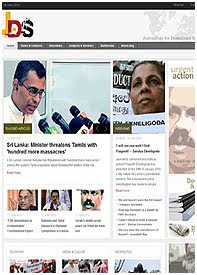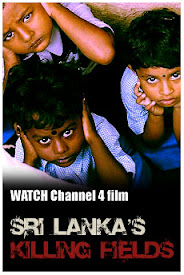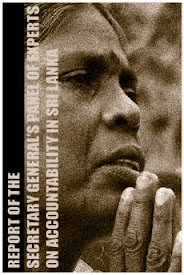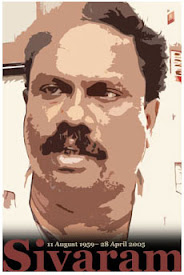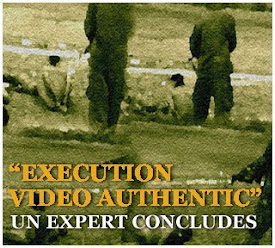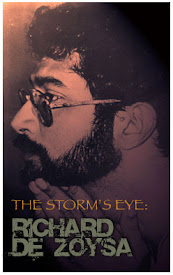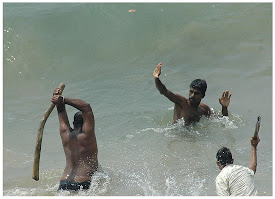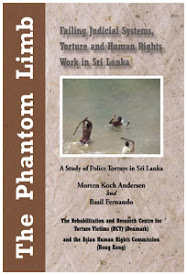
Deutsche Presse-Agentur | Monsters & Critics
.............................................................................................................................................................................................
The body of Roshen Shanaka was removed ahead of schedule from the house in Minuwangoda, 35 kilometres north of the capital, in an apparent move to prevent trade unionist and political parties from parading the coffin.
An estimated 5,000 soldiers were deployed to provide security at the funeral.
Shanaka died on Wednesday, two days after he was injured when police attacked employees demonstrating against a planned pension scheme.
The incident has sparked concern among foreign investors, with the German and Japanese embassies taking up the issue with the government.
Monday's protests were the country's biggest since government forces defeated Tamil rebels in northern Sri Lanka two years ago.
© M&C
Saturday, June 04, 2011
Thousands attend funeral of worker killed in Sri Lanka demo
Saturday, June 04, 2011
Sri Lanka deploys huge security for funeral

Photo courtesy: vikalpa.org
AFP | Google News
.............................................................................................................................................................................................
Troops in full-battle dress took up positions along the funeral route and surrounded a Catholic church where a service was held for slain factory worker Roshen Ratnasekera before burial.
Officials said a local magistrate had issued an order banning any political speeches at the funeral. The authorities had feared that opposition political parties could use the police killing to fuel anti-government protests.
Mourning factory workers were also prevented from entering the area in buses in a bid to prevent organised gatherings, officials said.
Sri Lanka is ruled under a state of emergency which allows the deployment of troops to maintain law and order and gives authorities the legal power to crack down on what they believe to be anti-state activities.
Troops were also deployed to shift his coffin to a church ahead of schedule.
"The cortege was supposed to leave the home in the afternoon but troops came in and removed the coffin during the morning," a witness told AFP from the victim's home outside the capital Colombo.
Heavily-armed troops remained deployed at a nearby free trade zone where Ratnasekera was shot and wounded on Monday along with over 150 men and women. He died at a hospital on Wednesday.
On Friday, hundreds of Buddhist monks marched to President Mahinda Rajapakse's tightly guarded official residence in Colombo and staged a sit-down demonstration demanding action over the police firing at protesting workers.
The government had proposed taking over the compulsory savings of workers in the private sector and paying them a smaller than expected state pension after retirement, but on Thursday made a formal announcement withdrawing the bill.
The country's chief of police, Inspector-General Mahinda Balasuriya, quit on Wednesday, taking responsibility for the use of live ammunition.
Sri Lanka's main opposition political parties have blamed the government for the violence.
© AFP
Saturday, June 04, 2011
Sri Lanka: Army takes dead worker's body for burial ahead of scheduled time

Photo courtesy: vikalpa.org
Sri Lanka Mirror
.............................................................................................................................................................................................
The Negombo magistrate had ordered that the funeral of the FTZ worker who died in a police shooting on a protest should take place at 3.00 pm today (June 04).
Roshan’s family had made arrangements accordingly.
However, several Army officers who had gone to his home this morning had taken the body to the Catholic church despite strong objections by the family members.
The buses transporting FTZ workers, who are arriving to pay their last respects to their colleague, are also being disrupted, reports said.
© Sri Lanka Mirror
Saturday, June 04, 2011
UN screens Channel 4 Sri Lanka war crimes film
To read the report of the UN Special Rapporteur click here
Channel 4
.............................................................................................................................................................................................
The documentary is an hour-long investigation into the final weeks of the bloody Sri Lankan civil war and features damning new evidence of war crimes and crimes against humanity.
Titled Sri Lanka's Killing Fields, Jon Snow presents the investigation which was shown to the United Nations Human Rights Council on Friday.
Disturbing footage in the film includes the apparent extra-judicial massacre of prisoners by government forces, the aftermath of targeted shelling of civilian hospitals and the bodies of female Tamil fighters who appear to have been sexually assaulted.
Also examined in the film are atrocities carried out by the Tamil Tigers, including the use of human shields, and footage depicting the aftermath of a suicide bombing in a government centre for the displaced.
The UN screening was attended by a number of ambassadors from nations including the US and UK.
A Sri Lankan delegation also attended. It was the first time they had seen the new alleged evidence of war crimes and crimes against humanity.
Sri Lanka's Killing Fields will be broadcast on Channel 4 on 14 June.
War crimes claims
In a world exclusive, Channel 4 News first broadcast the footage allegedly showing Sri Lankan government forces shooting dead bound prisoners in August 2009.
Last November, a second video of the same massacre emerged, revealing the naked dead bodies of at least seven women. The faces of some of the government troops could also be seen.
Following an investigation, Channel 4 News identified of one of the female victims in the video as a high profile member of the Tamil Tiger communications team. A potential date and location of the massacre was also determined.
Earlier this week, a UN special envoy said the footage appeared to be evidence of "serious international crimes".
The Sri Lankan government has consistently rejected the footage as falsified.
As the UN says it will continue its investigations, pressure has increased on the Sri Lankan authorities to allow an international inquiry into allegations that thousands of civilians were killed at the end of the 26-year war.
UN report
In April a 200-page report commissioned by UN Secretary-General Ban Ki-Moon concluded that up to 40,000 civilians may have died in the final push by the government to defeat the Tamil Tigers.
The UN report found credible evidence that both sides of the conflict committed serious war crimes. The report called for an international inquiry - that call has so far has gone unheard.
The Secretary-General said he lacked the authority to personally order an investigation into the mass killings.
A spokesman for Ban Ki-Moon said that without the consent of Sri Lanka's government ,or a decision by the UN Security Council, General Assembly, Human Rights Council or other international body, Ban will not move to set up a formal investigation of the civilian deaths.
UN officials concede that Colombo would never consent to such an investigation of its conduct in the conflict.
Sri Lanka has acknowledged some non-combatants were killed in the war, but says the numbers have been inflated by LTTE supporters.
© Channel 4
Saturday, June 04, 2011
Sri Lanka monks join anti-pension protests

Photo courtesy: Sampath Samarakoon - Vikalpa.org
By Amal Jayasinghe | AFP
.............................................................................................................................................................................................
The legislation sparked clashes with police on Monday in which a factory worker was fatally shot and more than 150 were wounded.
Saffron-robed clergy marched to President Mahinda Rajapakse's tightly-guarded official residence, known as "Temple Trees", and staged a sit-down demonstration, dispersing after chanting anti-government slogans.
A demand by the monks to meet with Rajapakse was rejected.
The monks left placards denouncing his administration. "End the dictatorial rule," read one board left on the main gate of Temple Trees.
A spokesman for the monks said they were expressing solidarity with private sector employees and also wanted Rajapakse to take action against those responsible for Monday's violence.
The government had proposed taking over the compulsory savings of workers in the private sector and paying them a smaller than expected state pension after retirement, but on Thursday made a formal announcement withdrawing the bill.
The monks' protest came as authorities deployed heavily armed troops around the country's main free-trade zone as tension mounted ahead of the weekend funeral of the factory worker killed by police firing.
The 22-year-old man died in hospital on Wednesday after being critically wounded in a demonstration against the proposed reform. Others suffered bullet injuries and broken limbs.
The country's chief of police, Inspector-General Mahinda Balasuriya, quit on Wednesday, taking responsibility for the use of live ammunition.
Soldiers were stationed in the Katunayake zone, next to the country's only international airport, where a range of international companies from India, Japan, China and South Korea are based, an official said.
A media report said that German-owned factories were among those damaged during Monday's rampage, which saw machinery destroyed.
"The army has been deployed to maintain order. They have also been deployed at police stations to prevent mobs attacking them," said an officer who declined to be named.
Sri Lanka's main opposition political parties have blamed the government for the violence.
© AFP
Saturday, June 04, 2011
Sri Lanka’s army chief dismisses video of war prisoner executions as ‘doctored’
By Associated Press | The Washington Post
.............................................................................................................................................................................................
A U.N. expert, Christof Heyns, concluded this week the 5-minute, 25-second video was authentic and contains enough evidence to open a war crimes investigation, but asked Sri Lanka to investigate the events first.
Army Commander Lt. Gen. Jagath Jayasuriya told reporters Thursday there are no clear details available on the video on the persons involved, place and day of the killings.
“We have said it’s a doctored video,” Jayasuriya said.
“These are general statements,” he said of the allegations. “If somebody says so and so did this at this place and this day and time, we can find answers to that.”
Heyns, a South African law professor who is also the U.N.’s independent investigator on extrajudicial killings, said that he viewed the video frame by frame with a team of technical and forensic specialists to determine it was authentic.
In the video, several men lie on a muddy track, bound and motionless. Another man is shown being forced to sit upright by a soldier in camouflage carrying a rifle. Another soldier steps up behind and shoots him in the back of the head, point blank. The prisoner slumps sideways as the camera pans across the road revealing nine bodies, most of them naked, with gunshot wounds clearly visible.
The uniformed men then force another blindfolded prisoner down into the dirt. A gunshot rings out and he, too, jerks and collapses. Later, the camera focuses on a young man, his skull blown open. Soldiers stand over the half-dressed corpse of a woman, gloating.
A partial U.N. count showed at least 7,000 ethnic Tamil civilians killed in the last five months of the conflict and relatives say a number of rebels surrendered or arrested at the end of the fighting are unaccounted for.
Also a U.N experts panel has said it has found credible allegations that serious human rights abuses took place in the final months of the civil war conducted away from public scrutiny, after evicting the U.N, independent reporters and aid workers.
The report said that government forces targeted civilians, hospitals and blocked food and medicine for hundreds of thousands of civilians trapped in the war zone and deliberately undercounted the number of civilians in the conflict zone.
It also alleged Tamil Tiger rebels recruited child soldiers, held civilians as human shields and shot dead those tried to escape their grip.
The government has repeatedly denied the allegations and the rebels are virtually nonexistent as an organization to respond.
U.N has estimated between 80,000 to 100,000 people may have been killed in the civil war but human rights groups say the number could be much higher.
Copyright 2011 The Associated Press. All rights reserved. This material may not be published, broadcast, rewritten or redistributed.
© The Washington Post
Saturday, June 04, 2011
Sri Lankans protest over killing of co-worker

Photo courtesy: Vikalpa.org
By Charles Haviland | BBC News
.............................................................................................................................................................................................
The workers, mostly women, chanted slogans against the police and President Rajapaksa opposite the entrance to the international airport.
They waved a large white cloth flag to symbolise the death of Roshen Chanaka.
Eyewitnesses say that the 22-year old man was shot dead in clashes between demonstrators and police on Monday.
The government has apologised, and two ministers have condemned the police tactics.
On Wednesday, in a move very rare in Sri Lankan political life, the police chief resigned as a result of the incident.
Protesters say that while the president had declared that the military were aware of the need to protect human rights, the same could not be said of the police.
Demonstrators on Thursday were hemmed in by soldiers, with the unpopular police nowhere to be seen.
The government is still popular following its victory against the Tamil Tigers two years ago. But economic hardships are growing in Sri Lanka.
The current dispute stems from an unpopular pension scheme, which would have docked an extra 2% from private sector workers' salaries, yet benefited only some of them.
The government has suspended the scheme but says it may yet bring it in again.
© BBC News
Saturday, June 04, 2011
War-Fighting Seminar: The heavy guns stayed silent

By Banyan | The Economist
.............................................................................................................................................................................................
The seminar ended on June 2nd, only a day after a UN special investigator at the United Nations Human Rights Council in Geneva showed video of Sri Lanka soldiers in the war’s final days, apparently executing civilians. He called it “trophy footage” and evidence of serious human-rights abuses.
And it doesn’t stop. On June 3rd, on the margins of sessions held by the UN Human Rights Council, Britain’s Channel 4 is set to screen a special one-hour investigation that it says will feature “devastating” new video evidence of war crimes and crimes against humanity, committed by both the Sri Lanka government’s forces and by the Liberation Tigers of Tamil Eelam (the LTTE).
The government’s response to every suggestion that it may be culpable for war crimes has been one of enraged denial. The seminar was like a prolonged exercise of the same. Ground commanders who had led troops in the scrutinised final battle against the rebels in 2009 were fulsome with self-congratulatory speeches claiming that the number of civilians killed by military fire was minimal.
As they would have it, the Tigers launched barrages of artillery and mortar fire at their troops from among civilians cowering in the congested no-fire zones declared by the army. And the army refrained from retaliating in kind.
But when members of the audience questioned the panellists about how they managed to crush the Tigers without killing civilians—given that the rebels held hundreds of thousands of people hostage, a massive human shield against their rapidly advancing forces—the replies were, at best, unconvincing.
One of the panellists, Major-General Shavendra Silva, who now serves as Sri Lanka’s deputy envoy to the UN in New York, said the army used “position targeting” as well as marksmen and snipers to identify and shoot only rebels and rebel targets.
But the army has long maintained that the Tigers fought in civilian clothes towards the end. So how could the snipers have picked out their men from the innocents? General Silva did not explain. Just when the questioning seemed like it was about to be trained on the subject of civilian casualties, the moderator hastily announced lunch.
The only speaker to address head-on the allegations of human-rights abuses—and the army’s implausible waffling about them—was not a Sri Lankan. David Kilcullen, an Australian consultant on counter-insurgency, said it was difficult to see how the international community could accept the Sri Lankan model without a frank and honest discussion of these allegations of abuse.
Mr Kilcullen offered that Sri Lanka might argue that whatever it took to defeat such an enemy, and so to end the conflict, was morally justifiable in the special circumstances of the final campaign. But even at the end of this seminar’s third day, Sri Lanka was doing nothing of the sort.
© The Economist
Saturday, June 04, 2011
Silence on Sri Lanka screams of duplicity

By Cynthia Banham | The Sydney Morning Herald
.............................................................................................................................................................................................
There's one aspect, however, of the protracted battle that the Sri Lankan government does not like to talk about, how in the final stages - a United Nations ''panel of experts'' says - up to 40,000 civilians may have been massacred.
And the international community is not terribly interested in such a discussion either. But, for the record, here are some of the horrific findings contained in the UN panel's nearly 200-page report, published in April.
In the final throes of the war, from September 2008 to May 2009, in the ever-shrinking areas controlled by the LTTE, and where hundreds of thousands of civilians still lived, the Sri Lankan government allegedly did the following.
Its army shelled a number of hospitals, killing patients. It shelled food distribution centres, killing and wounding civilians. It shelled civilians gathered in a government-declared no-fire zone. It also starved some of its population by deliberately underestimating the number of civilians in the LTTE areas, meaning only a fraction of the food aid needed got in. It stopped medical supplies getting into the worst-affected areas. The army shelled women and children queuing at a milk powder distribution line. And it abducted and caused to ''disappear'' not only suspected Tigers, but other government critics, including journalists and humanitarian workers.
Of course, atrocities were not just carried out by the Sri Lankan government. The Tigers were also bad. They forced children to become fighters; they used civilians as ''human buffers'' to protect their leadership; they fired on fleeing civilians - and all this after decades of carrying out deadly acts of terrorism, including suicide bombings.
Despite this you may have noticed a reticence on the part of the international community - so outraged in recent months about the killing of civilians in Libya - to talk about these allegations of war crimes.
There are various reasons for this. Gordon Weiss, the former UN spokesman in Sri Lanka, recently wrote in Foreign Policy magazine that ''against the backdrop of the 'global war on terror', a majority of nations were quietly glad that the Tigers were defeated''.
Sri Lanka is no doubt a much safer place these days without the Tigers. But it makes a mockery of the feel-good international principle which underpinned the action in Libya - the ''responsibility to protect''.
''R2P'' was adopted by the UN in 2005, based on the idea that when a nation state fails to prevent atrocities, or commits them against its people, the international community can step in to save lives. Military action is meant to be a last resort.
So where was ''R2P'' two years ago in Sri Lanka? Moreover, where is the self-examination by the international community today, now we have the UN experts' report, that more wasn't done to save tens of thousands of civilians in 2009?
Our own Foreign Affairs Minister, Kevin Rudd, just last week gave a speech about ''R2P''. He was vocal in advocating for the international community to intervene to protect Libya's civilians against the dictator Muammar Gaddafi. He mentioned Libya. He also mentioned Rwanda and Srebenica. But not a peep about Sri Lanka. In fact, as his department confirms, Rudd has not uttered a word about the UN report since its release. One wonders if the sole interest of the Rudd and now Gillard governments in Sri Lanka has been asylum seekers. Basically, we do not want them. (In 2009-10, Sri Lankan asylum seekers accounted for the second largest national grouping after Afghans.)
All of which suggests two things. First, it is a potent sign of how Janus-faced the Gillard/Rudd government foreign policy is. This is a government that wants a seat on the UN Security Council in 2013-14, as Rudd reminded us in his National Press Club address on Wednesday. Yet it does a deal with Malaysia - a country that tortures refugees, and has not signed the UN Refugee Convention - to take asylum seekers off its hands.
But it also tells us a lot about the flaws in the much-lauded R2P principle. The UN Security Council authorised action in Libya because the Arab League backed intervention, so Russia and China did not wield their veto powers. In Sri Lanka's case, the civilians were not so lucky. The Sri Lankan government had the support of India and China.
The UN Human Rights Council actually adopted a resolution in May 2009 applauding the government's defeat of the Tigers.
The UN High Commissioner for Human Rights, Navi Pillay, was in Australia last week and criticised Australia for its asylum seeker policies (much to Rudd's displeasure). I asked her about the discrepancy between the actions of the international community on Sri Lanka and Libya. Did it not demonstrate the shortcomings of the R2P principle, that it was subject to political will and therefore completely selective?
Pillay agreed. ''It is. It's at the will of the member states when they want to act to implement it,'' she said. ''So it's exactly what you are saying - but it doesn't mean when you set out a good principle that everyone will be supportive of applying it at all times. They should, but it's not done.''
Pillay's frank response made me think of something else I read recently, in John Howard's memoirs. I found it striking that of all the concluding statements he could make, Howard saved the second last paragraph of his book - the one before he thanks his party and his family - for an exhortation to Australians to be ''wary'' of multilateral organisations.
''We should be wary of giving unqualified assent to the dictates of multilateral bodies whose rules are written sometimes by majorities which include nations neither believing in nor practising the rule of law.''
That could be read as an obstinate Howard defending to the end his foreign policy decisions, especially on Iraq. But I also found it refreshing. Howard's scepticism of multilateralism is at least consistent. The current government's embrace of multilateralism is anything but.
© The Sydney Morning Herald
This site is best viewed with firefox

Search
Is this evidence of 'war crimes' in Sri Lanka?
Archive
- ► 2010 (1312)
-
▼
2011
(687)
-
▼
June
(82)
-
▼
Jun 04
(9)
- Silence on Sri Lanka screams of duplicity
- War-Fighting Seminar: The heavy guns stayed silent
- Sri Lankans protest over killing of co-worker
- Sri Lanka’s army chief dismisses video of war pris...
- Sri Lanka monks join anti-pension protests
- UN screens Channel 4 Sri Lanka war crimes film
- Sri Lanka: Army takes dead worker's body for buria...
- Sri Lanka deploys huge security for funeral
- Thousands attend funeral of worker killed in Sri L...
-
▼
Jun 04
(9)
-
▼
June
(82)
Links
- Reporters Sans Frontières
- Media Legal Defence Initiative
- International Press Institute
- International News Safety Institute
- International Media Support
- International Freedom of Expression eXchange
- International Federation of Journalists
- Committee to Protect Journalists
- Asian Human Rights Commission
- Amnesty International
